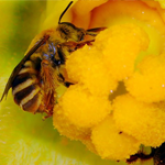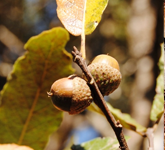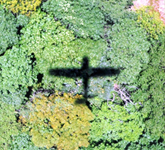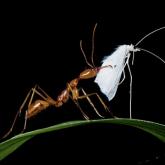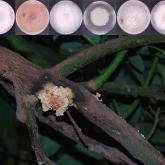Proyectos \
Genetics and conservation of temperate trees
Research Area: Genetics and conservation of temperate trees
Vulnerability of Mexican oak species under global change scenarios
Project Leaders:
Dr. Alberto Ken Oyama Nakagawa1
1
,
Dr. Antonio González Rodríguez1
2
,
Dr. Hernando Rodríguez Correa1
1
.
Working Group:
MSc. Yesenia Margarita Vega
.
1 Escuela Nacional de Estudios Superiores, Unidad Morelia, Universidad Nacional Autónoma de México
2 Instituto de Investigaciones en Ecosistemas y Sustentabilidad, Universidad Nacional Autónoma de México
Mexico is one of the most important hotspots of oak species diversity of the world. The number of oak species distributed through Mexico has been estimated around 160 species, of which 47 belong to the Quercus section and 61 to the Lobatae section. In addition, Mexico is also characterized by high levels of oak species endemism. From the total number of oak species, only 20 species are also distributed in Central America, while 33 are shared with the United States. Therefore, the 109 Mexican endemic oak species represent an important biological and genetic heritage, considering that Quercus forests in Mexico play a fundamental role in providing ecological and economical services.
However, Quercus species have been subjected to different anthropogenic pressures such as habitat fragmentation and degradation, mainly driven by their extensive use for charcoal and furniture production and the expansion of the agricultural frontier. In addition to the pressures mentioned above, climate change represents an additional and extremely worrying threat not only for the persistence of oak species in time, but also for the vast array of associated organisms that oak species sustain.
Under this scenario, it is fundamental to generate data repositories that integrate biological, environmental and social information resulting from the characterization of the ecological, evolutionary and cultural context that characterizes the oak forests in Mexico. This information will provide the baseline to generate management and conservation protocols for the oak forests and the ecological networks related to them. Likewise, the availability of this kind of data will bring important information regarding the historical processes that have determined the observed high levels of oak species diversity in Mexico from micro- and macro-evolutionary perspectives. In order to accomplish this general objective the Laboratorio Nacional de Análisis y Síntesis Ecológica para la Conservación de los Recursos Genéticos has proposed to establish a research program aiming at: i. to characterize the geography of the oak species in Mexico and ii. to determine the possible impact of the global climate change in the Mexican oak species, both by implementing GIS tools and environmental-based distribution modeling.
Landscape genetics of Quercus castanea Née (Fagaceae) in the Cuitzeo basin, Michoacan.
Project Leader:
Dr. Antonio González Rodríguez1
1
.
Working Group:
MSc. Ingrid Lara
.
1 Instituto de Investigaciones en Ecosistemas y Sustentabilidad, Universidad Nacional Autónoma de México
Landscape genetics is a discipline that aims to provide information about the interaction between landscape features (including environmental variables) and micro-evolutionary processes such as gene flow, genetic drift and selection. Understanding the processes and patterns of gene flow and local adaptation require a detailed knowledge of how landscape features structure populations. The oaks (genus Quercus: Fagaceae) are trees or shrubs, wind-pollinated and with acorns as characteristic fruit. They are dominant or co-dominant elements in temperate forests in Mexico. In the Cuitzeo basin, Michoacan, the oaks cover an area of 400 km2 (10% of the total basin area) and are distributed in more than 1000 fragments with different areas and shapes. In this basin, there is a precipitation gradient. The northern part of the basin is drier than the southern part; the minimum value of annual precipitation recorded is 646 mm and the maximum is 1402 mm. The oak species with the widest distribution in the basin is Quercus castanea Née. The populations of this species are distributed along the precipitation gradient, from sites with an annual rainfall of 850 mm to sites with an annual rainfall of 1200 mm.
The objective of this project is to investigate how landscape features (environmental variables) affect the genetic variability and the neutral and potentially adaptive differentiation, as well as the phenotypic variation in functional attributes of Quercus castanea populations in the Cuitzeo basin. For this purpose, a description of the hydrological gradient present in the basin will be conducted, and the relationship of genetic and eco-physiological variation with the gradient will be explored. The genetic variation will be analyzed with neutral microsatellites (SSR), gene-based microsatellites (EST-SSR) and candidate genes. The importance of this study is that it will contribute with information on the amount of genetic diversity and its spatial distribution in this ecologically and economically important oak; this information will be useful for the design of more efficient strategies for sustainable use to allow the conservation and / or restoration of oak forests along with the ecosystem services that they provide.
Landscape genetics of Salix humboldtiana (Salicaceae) in the Gulf of Mexico: gene flow and adaptive variation
Project Leader:
Dr. Antonio González Rodríguez1
1
.
Working Group:
MSc. Mariana Hernández Leal
.
1 Instituto de Investigaciones en Ecosistemas y Sustentabilidad, Universidad Nacional Autónoma de México
Landscape genetics is the study of how neutral variation and adaptation interact at the population level in a particular geographic space. This new approach incorporates environmental data, spatial statistics and the analysis of genetic variation at different scales (individual, population and metapopulation) in order to determine the relation between adaptive and environmental variation. Riparian forests constitute the interface between terrestrial and aquatic ecosystems. They encompass sharp gradients of environmental factors, ecological processes, and plant communities. In these ecosystems gene flow is dominated by landscape characteristics like stream direction, elevation and orography which can facilitate the flow or create barriers between populations.
The genus Salix L., is a common riparian component in the Northern Hemisphere. Salix species are commonly dioecious and reproduce sexually by plumbed seeds that are dispersed through wind and water, and asexually through branches that are swept downstream by the current. Salix humboldtiana is distributed from Mexico to the south of Argentina. In Mexico it is distributed along a wide altitudinal range (0-2500 m.a.s.l) and it is a common component of riparian forests. As a restricted riparian tree, it is sensitive to drought and cold, but it is reported that it can tolerate moderate levels of salinity. The main goal of this study is to determine the interaction between gene flow and adaptive variation at a fine scale in S. humboldtiana along an altitudinal and salinity gradient in three different rivers at the central part of the slope of the Gulf of Mexico. Different genetic markers like nuclear microsatellites will be used to elucidate the gene flow among populations. Also, common garden experiments and next generation sequencing will be used to determine if there are different responses amonog populations at different salinity treatments and which genes are involved in the adaptive response.




